Or stories about people sailing around their soul. Was Hieronymus Bosch’s “Garden of Earthly Delights” as puzzling as it claims to be. Perhaps only now, in our era of instant gratification, impatience for pleasure and fascination for a world in transformation, does it meaning become somewhat more defined in our new age of folly. Previously, we’ve looked at the left and right panels of the triptych; lets look at the large center panel….
The big central panel of the triptych stands between Paradise and Hell. It is a vision: an unnatural landscape crowded with naked human figures , animals both real and surrealistic, grotesque conglomerations of bodies and vegetable shapes, and dreamlike fantasies. It is a picture of madness, of insensate folly. Virtually nobody is doing any of the things that men and women do in normal life; most of the huge crowd is very busy doing things that are absurd.
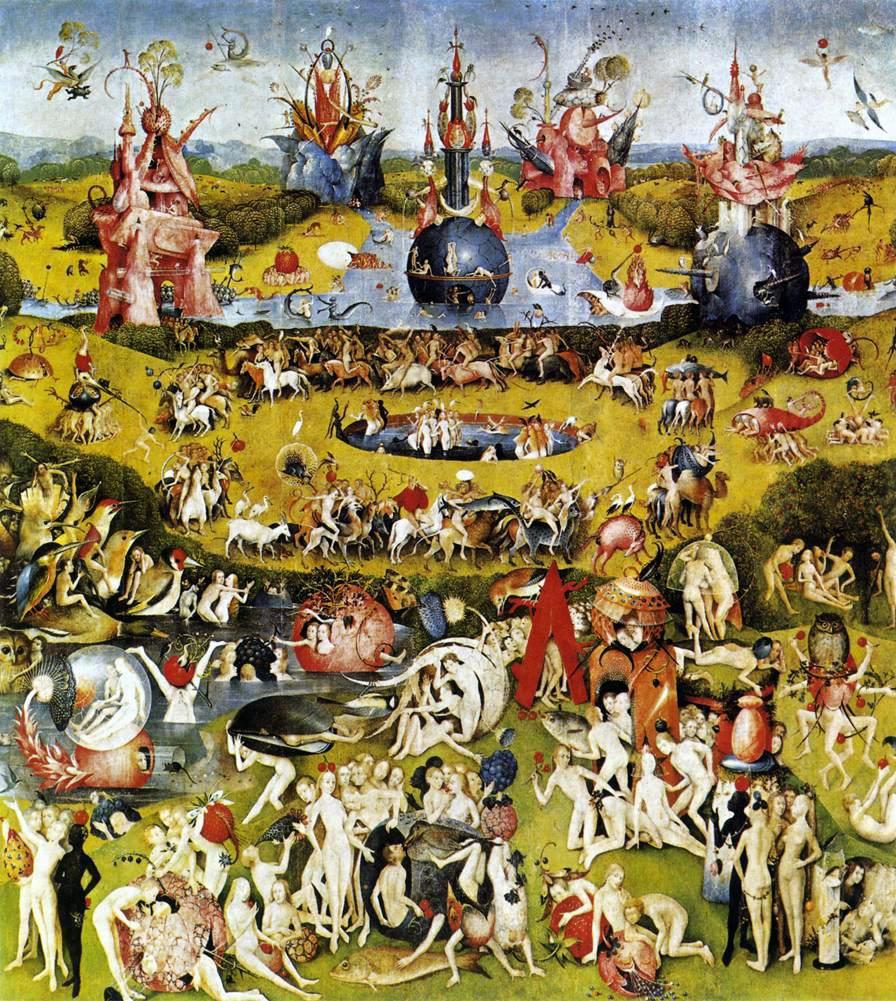
Michel Foucault:The classical experience of madness is born. The great threat that dawned on the horizon of the fifteenth century subsides, the disturbing powers that inhabit Bosch's paint-ing have lost their violence. Forms remain, now transparent and docile, forming a cortege, the inevitable procession of reason. Madness has ceased to be-at the limits of the world, of man and death-an eschatological figure; the darkness has dispersed on which the eyes of madness were fixed and out of which the forms of the impossible were bom. Oblivion falls upon the world navigated by the free slaves of the Ship of Fools. Madness will no longer proceed from a point within the world to a point beyond, on its strange voyage; it will never again be that fugitive and absolute limit. Behold it moored now, made fast among things and men. Retained and maintained. No longer a ship but a hospital. ...Read More: http://prernalal.com/scholar/Foucault%20-%20Madness%20and%20civilization.pdf
Michel Foucault: …In any case, the Reason-Madness nexus constitutes for Western culture one of the dimen-sions of its originality; it already accompanied that culture long before Hieronymus Bosch, and will follow it long after Nietzsche and Artaud….And confronting all these discussions, with their tireless dialectic, confronting these discourses constantly reworded and reworked, a long dynasty of images, from Hieronymus Bosch with The Cure of Madness and The Ship of Fools, down to Brueghel and his Dulle Griet, woodcuts and engravings transcribe what the theater, what literature and art have already taken up: the intermingled themes of the Feast and of the Dance of Fools. Indeed, from the fifteenth century on, the face of madness has haunted the imagination of Western man…. Read More: http://prernalal.com/scholar/Foucault%20-%20Madness%20and%20civilization.pdf
The little group that best typifies the whole thing is composed of two people, stark naked, dancing merrily, interlocked by branches of a fruit tree, and wearing as a headdress, a huge solemn owl. Others are standing in swimming pools; some are playing with gigantic birds and fishes; many are riding animals, real and imaginary; many are just chatting or playing little tricks on one another; one is cuddling, not a girl, but a giant strawberry. Yet the remarkable thing is this: no one is doing anything really evil, and no one looks as if he or she were conceived and presented as positively wicked, dangerously sinful.
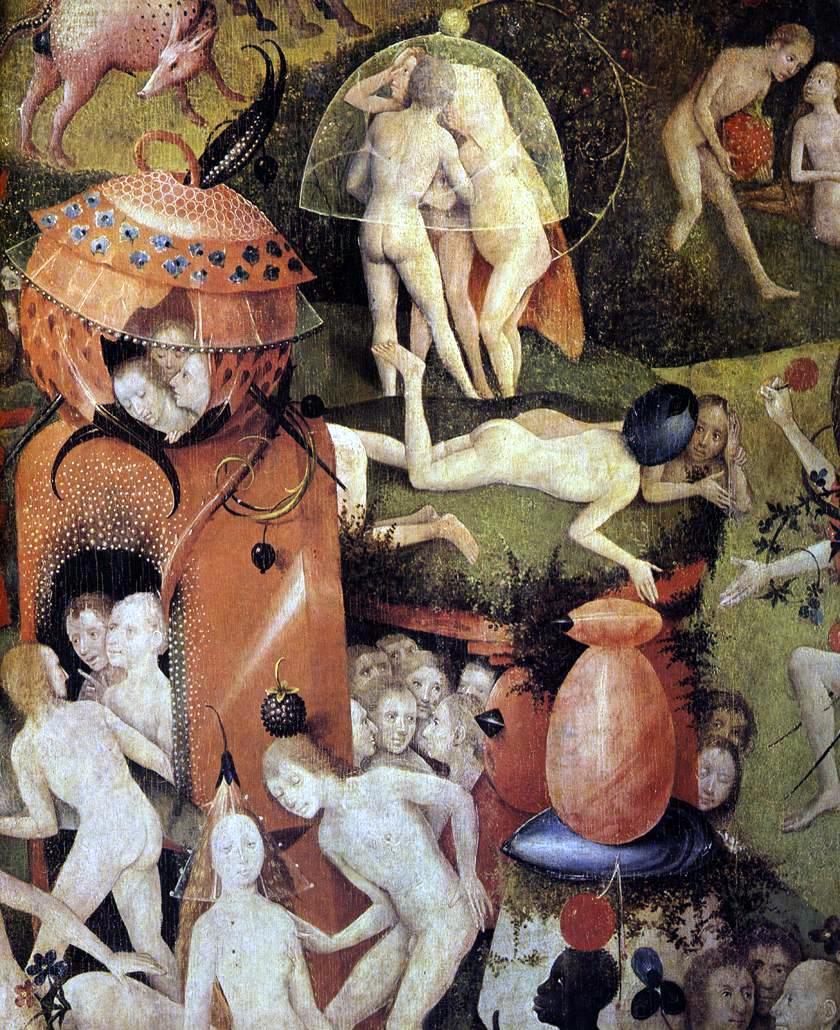
Center panel detail. Foucault:What the classical period had confined was not only an abstract unreason which mingled madmen and libertines, invalids, and criminals, but also an enormous reservoir of the fantastic, a dormant world of monsters supposedly en-gulfed in the darkness of Hieronymus Bosch which had once spewed them forth. One might say that the fortresses of confinement added to their social role of segregation and purification a quite opposite cultural function. Even as they separated reason from unreason on society's surface, they preserved in depth the images where they mingled and ex-changed properties. The fortresses of confinement func-tioned as a great, long silent memory; they maintained in the shadows an iconographic power that men might have thought was exorcised; created by the new classical order, they preserved, against it and against time, forbidden fig-ures that could thus be transmitted intact from the six-teenth to the nineteenth century. image: http://www.siue.edu/babel/SpeculativeMedievalismsLondon2011.htm
These faces are mostly calm and composed. Everybody is about twenty years old. There are no old sinners or young perverts. No one is leering or slobbering with greed; no one is angry or overexcited. And although there are scores of men and women in the picture, all naked, few of them show any signs of sexual desire. One fellow standing in the river has grabbed a woman, who looks a bit shocked, as though such a thing were against the rules, and yet is returning his caresss;another couple sitting inside a transparent bubble are fondling each other gently; and a third are exchanging a kiss through an aperture in a monstrous fruit. For the rest, it might be a well-conducted nudist camp.

Bosch, Ship of Fools. "As for the famous Ship of Fools, is it not a direct translation of Brant's Narrenschiff, whose tide it bears, and of which it seems to illustrate quite precisely canto XXVII, also con-secrated to stigmatizing "drunkards and gluttons"? It has even been suggested that Bosch's painting was part of a series of pictures illustrating the principal cantos of Brant's poem." Read More: http://library.thinkquest.org/C0125867/web_e/artwork_Hieronymus.htm
Foucault: In the very last years of the century Hieronymus Bosch painted his Ship of Fools. The Praise of Folly dates from 1509. The order of succession is clear. Up to the second half of the fifteenth century, or even a little beyond, the theme of death reigns alone. The end of man, the end of time bear the face of pestilence and war. What overhangs human existence is this conclusion and this order from which nothing escapes. The presence that threatens even within this world is a fleshless one. Then in the last years of the century this enormous uneasiness turns on itself; the mockery of madness replaces death and its solemnity. From the discovery of that necessity which in-evitably reduces man to nothing, we have shifted to the scornful contemplation of that nothing which is existence…Read More:http://prernalal.com/scholar/Foucault%20-%20Madness%20and%20civilization.pdf
Though the people are naked, they do not appear sexy. And there is no violence worth mentioning. No one is robbing his neighbor , or torturing him, or trying to kill him. One character is sticking flowers into a friend’s backside, but the friend looks as if he were enjoying it. Now what is the meaning of all this? The picture is often called “The Garden of Earthly Delights” , but the occupations of its inhabitants are not the normal pleasures of humanity. It may be delightful to carry a six-foot long mullet while riding a lion, but most of us can do without the experience. Hugging a huge strawberry, toting a large mussel shell with people inside it, and crowding into a big empty egg are occupations that give little enjoyment and must soon grow boring.
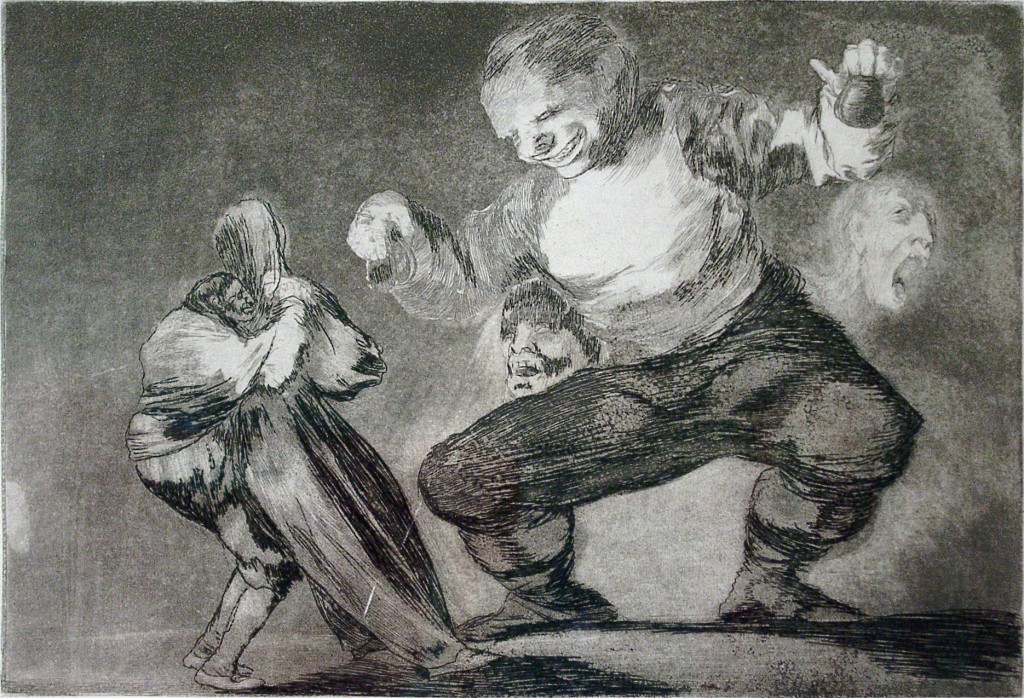
Goya. Disparates Series. "The Goya of the Disparates and the Quinta del Sordo addresses himself to another madness. Not that of madmen cast into prison, but that of man cast into darkness. Does Goya not link us, by memory, with the old world of en-chantments, of fantastic rides, of witches perched on the branches of dead trees? Is not the monster whispering its secrets into the ears of the Monk related to the gnome who fascinated Bosch's Saint Anthony? But they are different for Goya, and their prestige, which overshadows all his later work, derives from another power. For Bosch or Brueghel, these forms are generated by the world itself; through the fissures of a strange poetry, they rise from stones and plants, they well out of an animal howl; the whole complicity of nature is not too much for their dance. Goya's forms are born out of nothing: they have no back-ground, in the double sense that they are silhouetted against only the most monotonous darkness, and that nothing can assign them their origin, their limit, and their nature.
t; Read More: http://counterlightsrantsandblather1.blogspot.com/2009/12/true-or-not.htmlFoucault: Another symbol of knowledge, the tree (the for-bidden tree, the tree of promised immortality and of sin), once planted in the heart of the earthly paradise, has been uprooted and now forms the mast of the Ship of Fools, as seen in the engraving that illustrates Josse Bade’s Stultiferae naviculae; it is this tree, without a doubt, that sways over Bosch’s Ship of Fools. What does it presage, this wisdom of fools? Doubtless, since it is a forbidden wisdom, it presages both the reign of Satan and the end of the world; ultimate bliss and supreme punishment; omnipotence on earth and the infernal fall. The Ship of Fools sails through a landscape of delights, where all is offered to desire, a sort of renewed paradise, since here man no longer knows either suffering or need; and yet he has not recovered his innocence. This false hap-piness is the diabolical triumph of the Antichrist; it is the End, already at hand. Apocalyptic dreams are not new, it is true, in the fifteenth century; they are, however, very different in nature from what they had been earlier. The
delicately fantastic iconography of the fourteenth century, where castles are toppled like dice, where the Beast is al-ways the traditional dragon held at bay by the Virgin, in short where the order of God and its imminent victory are always apparent, gives way to a
vision of the world where all wisdom is annihilated. Read More:http://prernalal.com/scholar/Foucault%20-%20Madness%20and%20civilization.pdf
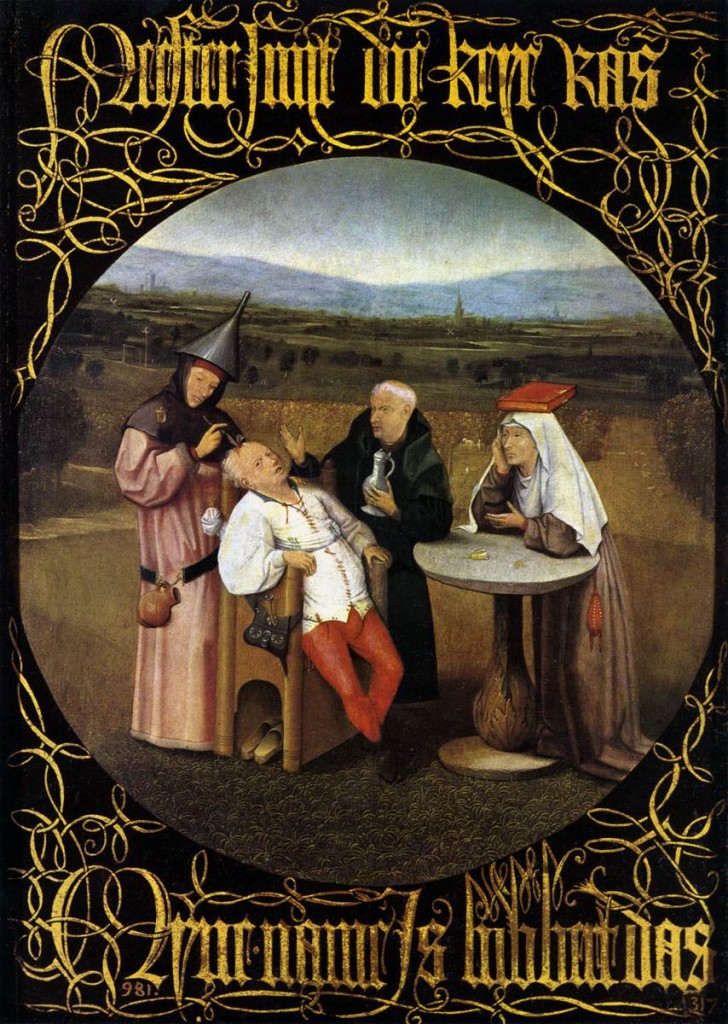
Bosch. Cure of Madness. "At Bioephemera, Jessica has a fascinating post about depictions of madness in 15th-17th century art, during which time mental illness was popularly attributed to the presence of a "stone of madness" (or "stone of folly") in the head. One of the earliest depictions of this is found in the above painting, Hieronymous Bosch's The Cure of Folly (The Extraction of the Stone of Madness), and similar scenes were subsequently depicted by other Renaissance artists. As Jessica explains, historians of art and medicine are in dispute about the underlying meaning of the paintings. Were they depictions of real procedures, or allegorical statements about the human condition?..." Read More: http://scienceblogs.com/neurophilosophy/2008/08/cutting_out_the_stone_of_madness.php
ADDENDUM:
Michel Foucault: What, then, is this confrontation beneath the language of reason? Where can an interrogation lead us which does not follow reason in its horizontal course, but seeks to retrace in time that constant vertically which confronts European culture with what it is
not, establishes its range by its own derangement? What realm do we enter which is neither the history of knowledge, nor history itself; which is con-trolled by neither the teleology of truth nor the rational sequence of causes, since causes have value and
meaning only beyond the division? A realm, no doubt, where what is in question is the
limits rather than the identity of a culture. Read More: http://prernalal.com/scholar/Foucault%20-%20Madness%20and%20civilization.pdf
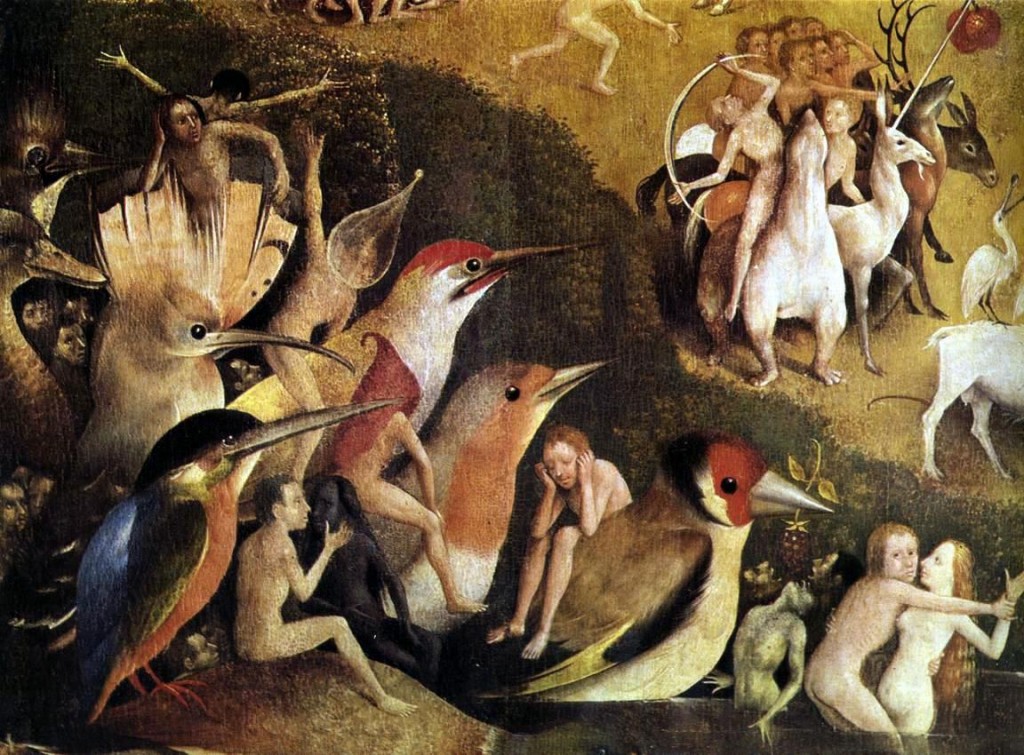
"Throughout the triptych, says Dixon, alchemical symbols can be found. In the center panel, the red balls represent the perfect medicine, the elixir of life. And the fountain of life recalls the shape of a laboratory beaker or the "distillation chamber in which the opposites were mixed." So, too, do the glass bubbles and tubes appear similar to other alchemical devices. But most symbolic of alchemy is the egg, the vessel where all ingredients are combined; it appears in all four scenes of the triptych." Read More: http://www.stanleymeisler.com/smithsonian/smithsonian-1988-03-bosch.html
Foucault:….Whereas Bosch, Brueghel, and Diirer were ter-ribly earth-bound spectators, implicated in that madness they saw surging around them, Erasmus observes it from far enough away to be out of danger; he observes it from the heights of his Olympus, and if he sings its praises, it is because he can laugh at it with the inextinguishable laugh-ter of the Gods. For the madness of men is a divine spec-tacle: “In fact, could one make observations from the Moon, as did Menippus, considering the numberless agita-tions of the Earth, one would think one saw a swarm of flies or gnats fighting among themselves, struggling and lay-ing traps, stealing from one another, playing, gamboling, falling, and dying, and one would not believe the troubles, the tragedies that were produced by such a minute animal-cule destined to perish so shortly.” Madness is no longer the familiar foreignness of the world; it is merely a com-monplace spectacle for the foreign spectator; no longer a figure of the cosmos, but a characteristic of the aevum….





 COMMENTS
COMMENTS